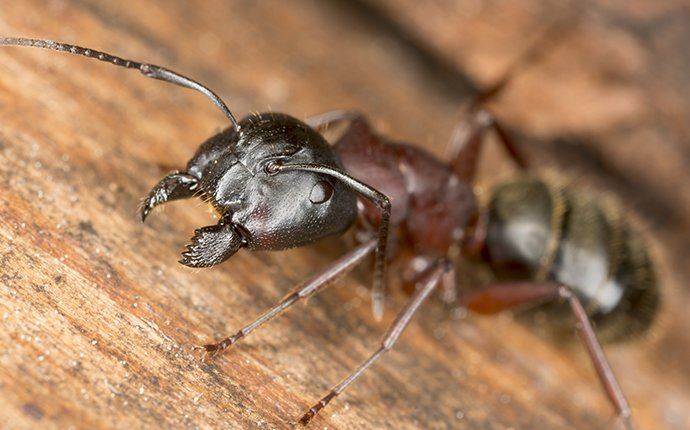

Carpenter Ants
(Camponotus)
What are carpenter ants?
Carpenter ants are large ants that are easily visible and often found walking around our indoor and outdoor spaces. They are typically black but can also be red or a combination of red and black. When carpenter ants live out in nature, their nesting habits help speed up the decay of dead wood, and their feeding habits help control insect populations.

However, carpenter ants are a bit more problematic when living near people and can be especially prevalent in the fall. Carpenter ants are wood-destroying pests and always an unwanted sight in our yards and homes.
Are carpenter ants dangerous?
Though carpenter ants work at a slower pace damaging wooden structures than other wood-destroying pests, having these large ants on your property should never be taken lightly. Given enough time, carpenter ants can cause extensive and costly damage to our structures as they create more and more tunnels and nesting galleries. Carpenter ants will also cause other problems inside our homes, including the contamination of surfaces and food with their excrement and the bacteria they carry on their bodies.
Why do I have a carpenter ant problem?
Carpenter ants want to nest outside in decaying or water-damaged wood. But, like other ants, they are often drawn into our homes by food and moisture. Once inside, it is common for these ants to decide to stay and expand their colony’s nesting sites in structural wood.
A carpenter ant infestation can occur anywhere, but homes and businesses located near wooded areas or areas with a lot of wood debris tend to be more susceptible. Also, houses with moisture issues caused by leaks will attract carpenter ants and other insect activity.
Where will I find carpenter ants?
When carpenter ants are nesting outside, they usually are found in logs, fallen trees, tree stumps, or under woodpiles.
When they move into our homes and other structures to nest, they like to tunnel through wood damaged by water due to poor ventilation, leaking pipes, or dripping fixtures.
The structural wood behind walls or under floors near windows, doors, sinks, tubs, air conditioners, and water pipes are other popular nesting sites.
Unlike termites that feed on wood, carpenter ants have a varied diet and feed on things like sweets, proteins, and grease. These ants do not eat the wood they are nesting in. It is common to see these large ants wandering around gardens, sidewalks, porches, outdoor eating areas, and our kitchens searching for food.
How do I get rid of carpenter ants?
The secret to getting rid of carpenter ants and preventing their return is to partner with the professionals at Chase Pest Control! Since 1997 our family owned and operated business has been dedicated to protecting people and properties in Montgomery County, Texas, against carpenter ants and other area pests. We know how difficult eliminating carpenter ants can be and how much damage they can cause to the structures they have invaded. To combat ants, we offer the effective services necessary to eliminate these pests as quickly as possible, minimizing the damage they can cause.
Learn more about our reliable home pest control or commercial pest management services by giving Chase Pest Control a call today!
How can I prevent carpenter ants in the future?
When it comes to preventing problems with destructive, wood-eating carpenter ants, it is always best to partner with a professional. In addition to implementing professional pest control services from Chase Pest Control, the following tips will help you avoid carpenter ants problems.
- Remove potential nesting sites from your property like fallen trees, construction debris, tree stumps, logs, old wooden fencing, and woodpiles.
- Make sure that gutters and weatherstripping are in place to prevent rainwater from seeping into your house and causing water damage.
- Repair leaky pipes.
- Make sure attics and crawl spaces are well-ventilated.
- Create a barrier between any mulch and your foundation.
- Repair any damage you find in the foundation, roof, or exterior walls of your home.
- Store trash cans and recycling bins a distance away from the outside of your house, and make sure they have tight-fitting lids.
- Maintain gardens and compost areas.
- Keep indoor and outdoor eating areas free of leftover food, food debris, and sticky spills.

Pest-Free Homes, Happy Clients
What Our Customers Are Saying
At Chase Pest Control, your satisfaction is our priority! See for yourself what our customers have to say about working with us.
-
"Truly went above what we had expected."We have never had such good, thorough service! Our tech was polite, knowledgeable, and truly went above what we had expected. Certainly glad we have found them. We have already recommended them to another neighbor.- Anne V.
-
"We have been using only Chase Pest Control for 6 years."Their service-person is always on-time, is always thorough and pleasant. Our home is over 35 years old - but we hardly ever see a roach or ant inside. We highly recommend Chase Pest Control!- John P.
-
"Chase Pest Control is the best in the business!"Fair pricing- Responsive- Professional Technicians! We had an ant issue arise and with a simple phone call we had a technician out with a few hours! You cannot beat their service!- Kendall H.
-
"Nothing but prompt and professional!"I’ve been very happy with Chase Pest Control and the service we have received at my business over the past several years! Stephen has been nothing but prompt and professional. Highly recommend!- AJ D.
-
"Chase Pest Control was highly recommended by friends."They couldn't have sent us in a better direction. Friendly staff, knowledgeable, responsive, caring, and the list goes on. We will continue to use them for pest prevention and any pest problems we may encounter.- Bailey E.
-
"Very friendly, efficient, and respectful of your home."Andy is awesome! He came in and finished services quickly, while explaining their scheduling program, and did a thorough search of my home to ensure it was pest-free.- Lauren F.
-
"Best in the business!"Cary and his team have been exceptional with their pest prevention! Their team has been nothing but great over the last couple of years.- Cameron H.
-
"I would give more stars if I could!!!"Stephen gives outstanding customer service and goes above and beyond to put the customer first! Highly recommend!!!- Michael S.